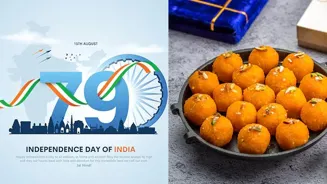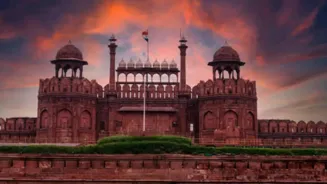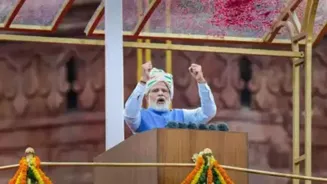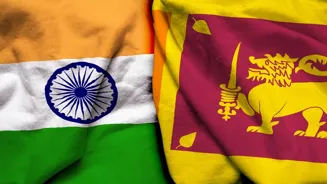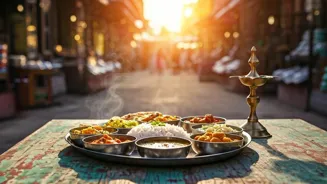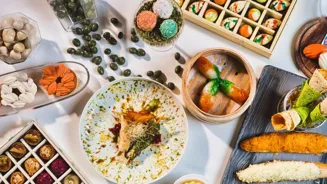Independence Day celebrations feel incomplete without a bite of motichoor laddu. But ever wondered why?
On the morning of Independence Day, after the tricolor
flutters high and proud, there's one thing almost every Indian looks forward to: the sweet treat that follows. And among all the delights, it’s the humble motichoor laddu that steals the show. While jalebis and barfis make appearances, the soft and saffron-hued laddu feels just right for the occasion. However, have you ever wondered why and how motichoor laddu, of all sweets, became such a staple on August 15? Why not rasgulla or peda? Turns out, this isn’t just a matter of taste or tradition, but there’s actually history behind it.
So today, as India celebrates its 79th Independence Day, let’s uncover the lesser-known story of how this iconic sweet became tied to the soul of our nation’s biggest celebration.
A Sweet Beginning in 1947
It was the dawn of a free India. As the Union Jack came down and the Indian flag rose for the very first time on August 15, 1947, celebrations naturally broke out across the country. And in the heart of Delhi and across towns and villages, people shared sweets as a symbol of joy and unity.
According to cultural researcher and food writer Pushpesh Pant, sweets (especially laddus) have long held ceremonial importance in Indian society. He once noted in an interview, “Distributing sweets is our instinctive way of sharing happiness.”
Historical anecdotes suggest that during the first Independence Day celebrations, motichoor laddus were chosen for their availability and cost-efficiency. In North India, where Delhi was the power centre, motichoor laddu was a popular and widely made sweet, especially in temples and community kitchens. It was easy to prepare in large quantities, didn’t spoil quickly, and most importantly, it felt celebratory.
Taking the oath of office as Prime Minister of Independent India , at Viceroy's House , New Delhi ,15 August 1947.#JawaharlalNehru . pic.twitter.com/TQ6qkF2sZa
— Jawaharlal Nehru Memorial Fund (@jnmfsm) July 4, 2025
(Credit: Jawaharlal Nehru Memorial Fund)
As government offices and schools adopted a uniform mode of marking Independence Day each year, the motichoor laddu became a staple.
The Symbolism Behind the Sweet
Unlike other Indian sweets, the motichoor laddu carries a striking saffron-orange color that also adorns the Indian national flag and stands for courage and sacrifice. In many cultural interpretations, this made it a symbolic sweet. On the other hand, its round shape has been viewed as a metaphor for unity and wholeness. Made with countless tiny boondis (droplets), each laddu signifies how individual efforts, when brought together, can create something bigger, just like India's freedom movement. The soft texture and rich aroma made it a comforting reminder of home, especially for those who had lived through the trauma of Partition.
Compared to sweets like jalebi (sticky), or rasgulla (syrupy and more fragile), motichoor laddus were easier to transport and distribute in paper packets, especially in large public gatherings.
How the Tradition Spread Across India
What began in North India gradually became a national tradition. By the 1950s and ’60s, the distribution of laddus after flag hoisting became standard practice; first in schools and government institutions, then in private colonies and corporate offices.
One of the most iconic moments of this tradition plays out every year at the Red Fort, where the Prime Minister hoists the national flag. After the speech, thousands of attendees (including children, NCC cadets, soldiers, and guests) were served motichoor laddus. Reports suggest that nearly 10,000 laddus are distributed each year at the Red Fort alone.
In some states, local variations of laddus (like besan or boondi) are also served, but motichoor remains the most popular across central and northern India. Over time, sweet-makers began preparing special "Independence Day batches," and many old halwais (traditional sweet shops) proudly speak of serving their laddus to politicians and freedom fighters in the early decades of Independence.
Lesser-Known Stories from the Sweet Side of History
In Tihar Jail, Delhi, a lesser-known but deeply moving tradition takes place every year. Inmates (many of whom are trained in culinary arts) prepare thousands of motichoor laddus that are then distributed at government functions and public events.
In Kanpur, the family of a renowned sweet-maker, late Shri Ramnath Gupta of Thaggu ke Laddu, claims that their shop supplied laddus to a local independence gathering in 1947, where leaders addressed a crowd of over 5,000. “My grandfather said the entire city smelled of ghee and freedom that day,” said his grandson in an interview, now running the shop.
You see, it is not just about taste. It’s about tradition. And more importantly, it’s about memories of standing in a school courtyard, holding a fluttering flag in one hand and a greasy paper with a warm laddu in the other. Also, it's about tasting a piece of India’s journey.
